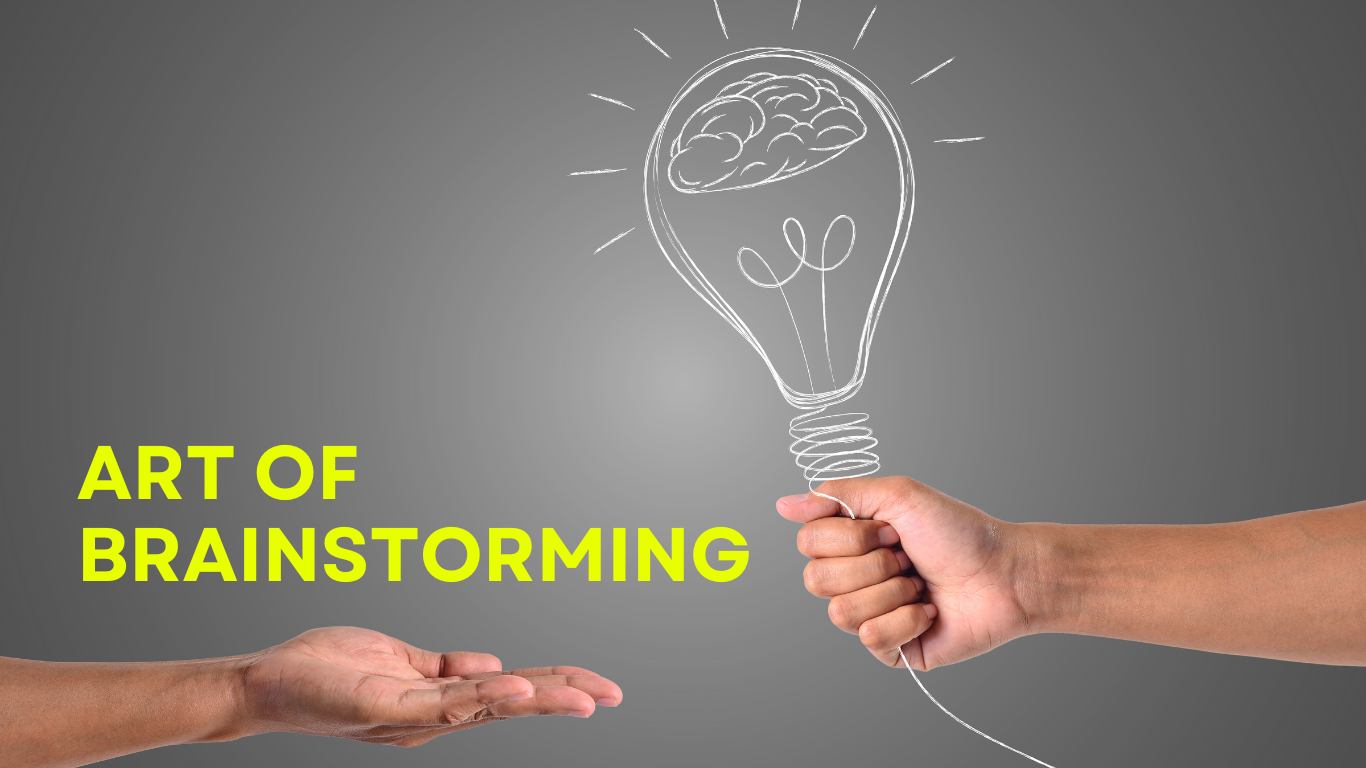216Views 0Comments
Art of Brainstorming

Exploring the Art of Brainstorming: Enhancing Your Team or Organization
Welcome to this blog post, where we’ll dive into the world of brainstorming and how it can work wonders for your company, team, or any group of people. Whether you’re dealing with a tough problem or just want to make your family dynamics more interesting, brainstorming can be a fantastic help. You don’t need fancy stuff, just your own brainpower. So, let’s get started and discover the four basic rules for having a great brainstorming session.
What Does Brainstorming Mean?

Brainstorming is a method widely used by big companies and thought groups. It’s all about bringing people together to brainstorm ideas and solutions for a particular problem. The aim is to spark creativity and open-minded thinking without any negative feedback or criticism. Brainstorming is a valuable technique that enables teams to harness their combined wisdom and devise creative solutions. By establishing a supportive atmosphere where every idea is welcomed, even the wildest ones, brainstorming aids in breaking away from traditional thinking and venturing into uncharted territories.
The Brainstorming Process
Brainstorming typically follows these steps :
1. Define the Issue: First, you need to have a clear understanding of the problem or challenge your team aims to address. It could be anything, from creating a new product or service to enhancing an existing process.
2. Lay Down the Rules: Before the brainstorming session kicks off, it’s essential to establish a set of ground rules. These rules include encouraging everyone to voice their thoughts, steering clear of judgment or criticism, and capturing all ideas without judgment.
3. Generate Ideas: The next phase is all about generating as many ideas as possible. This can be done through open discussions, individual brainstorming, or both. Here, the focus is on quantity, not quality.
4. Expand on Ideas: Once a plethora of ideas is on the table, your team can start building upon them. This means seeking connections between ideas, refining and elaborating on concepts, and identifying potential solutions.
5. Assess and Select: After the brainstorming session, your team can assess the ideas and choose the ones with the most promise. Criteria like feasibility, impact, and alignment with the problem statement can guide this process.
6. Create an Action Plan: Once the ideas are chosen, your team can craft an action plan to implement them. This involves identifying the necessary resources, setting a timeline, and assigning responsibilities.
No Critiques of Others’ Ideas
In brainstorming, a fundamental principle reigns: refrain from critiquing others’ ideas. This means that all ideas, unconventional or bizarre, are deemed valuable and valid until the evaluation phase.
By cultivating an open and accepting environment, participants are more likely to feel at ease sharing their ideas without the fear of criticism or judgment. This can generate a broader spectrum of ideas, enhancing the likelihood of discovering innovative solutions to challenges.
Throughout the brainstorming session, it is crucial for participants to actively listen and show respect for one another’s ideas. This involves avoiding immediate dismissal or criticism of an idea and, instead, taking the time to understand and acknowledge its potential value fully.
Freewheeling is welcome
It’s a good thing to have freewheeling in the process of creativity, but sometimes, the most innovative ideas can lead to the most inventive solutions. That’s why it’s not only a part of brainstorming sessions but is in fact, one of the fundamental guidelines. Freewheeling refers to the capacity to let your imagination go wild and experiment with concepts that at first appear absurd or out of the ordinary. Through cultivating a sense of curiosity and acceptance of the odd, participants can use their imaginative thinking capabilities and challenge traditional limits. The encouragement to be free can result in a breakthrough, where an unorthodox idea can spark an idea that results in an original solution. It is essential to ensure that participants are reminded that nothing is excessively crazy or out of reach because it’s often the ideas that pave the way to breakthrough ideas. When you are in the process: Reserve an hour during the brainstorming session to allow playing around. Instruct participants to let their imaginations run wild and be open to any ideas, regardless of how bizarre they might appear.
Quality over quantity
When brainstorming, the primary focus should be on creating many ideas instead of focusing on their merits. The greater the number of options you can choose from, the greater the chance of coming up with the most creative solution. In focusing on quantity over quality, Participants are urged to think quickly and freely and without being caught up with self-criticism and perfectionism. This mentality allows for a better flow of thoughts and stops people from quickly removing ideas that could be valuable. Creating an environment where people feel comfortable sharing their simplest or unfinished concepts is essential. Instruct them that no thought is too small or unimportant to be used as a base for a more refined approach.
Provide each participant with a pen and paper to jot down their ideas
To facilitate the brainstorming process, provide each participant with a pen and paper.
It allows them to write down ideas as they develop their ideas. Using a paper to write on will enable participants to organise their thoughts and ensures that ideas are not lost in the discussion. Note the issue at the time.
Write the problem at the top of a flip chart or whiteboard
To ensure the group stays focused during brainstorming sessions, write the issue or subject at the top of whiteboards or flip charts. This serves as a continual reminder to keep participants focused when generating solutions. This helps ensure all participants are on the same team and pursuing the identical end goal.
Duration of Sessions
The management of time is essential in a brainstorming session for a group. You should aim for a time of 30 minutes to 1 hour, based on the difficulty of the issue to be solved. This allows the participants to explore the subject in depth without becoming exhausted. You can easily alter the length according to your team’s requirements and needs. Solving a problem quickly isn’t always feasible or desirable in a brainstorming session. It’s crucial to remind participants to be jolly and enjoy the process regardless whether immediate solutions are discovered. A positive and enjoyable atmosphere promotes creativity and encourages collaboration between participant.
Conclusion
In brainstorming, people have seen the incredible power of collective thinking and solving problems. Adhering to four basic rules and running regular discussions can generate many creative ideas for your organisation or team.
In these gatherings for brainstorming in these brainstorming sessions, we create a place in which free-thinking and open communication reign in the top spot. When we allow our minds to roam free of conventional boundaries, we can unlock the potential to create new and innovative ideas. This helps us remain at the forefront of our areas, always one step ahead of our competitors.
What makes brainstorming so successful is the ability to draw on the different viewpoints and experiences of people in the room. When people from diverse backgrounds come together to solve the problem, they can bring a wealth of knowledge and concepts. This diversity helps to enrich our process of creativity, which results in more holistic and creative solutions. To ensure the effectiveness of a meeting, brainstorming sessions must follow some fundamental rules.
-First, we are open to and welcome any ideas. Each thought is welcomed with open arms, and we make no space for criticism or dismissal in our discussions. This creates a secure and unbiased space where every voice can be heard freely.
-Second, we build on our ideas. Instead of taking down thoughts and ideas, we work on developing and enhancing their quality. The collaborative and supportive environment ensures that everyone feels appreciated, knowing their contribution is essential.
-The third point is that the quantity of ideas is a great good friend. If you’re in the business of brainstorming, the more ideas are generated, the more productive. We encourage participants to be creative and to come up with ideas quickly without thinking about feasibility or practicality at this point.
-Finally, a systematic method helps keep our brainstorming sessions productive and on the right path. The first step is clearly defining the problem or issue we face. We then encourage everyone to come up with concepts on their own before sharing ideas in the larger group. In this way, everyone has the chance to contribute to the group, and we avoid the risk of groupthink.
Ultimately, brainstorming is our most trusted partner for unlocking collective creativeness and problem-solving. It allows us to harness the many perspectives within our teams and create creative solutions. Following these basic guidelines for brainstorming and conducting regular sessions can pave our path to success. Let’s enjoy the freedom to think outside of the box and revel in the fun of brainstorming with others!


